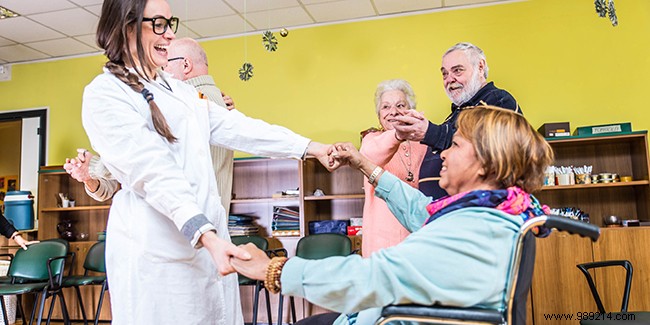
Anyone who has a relative in an Ehpad has necessarily already met a facilitator there (they are mostly women). Perhaps you found yourself visiting while your loved one was taking part in an activity? A program is generally established on a weekly basis and available to residents' families. This animation position should not be taken lightly, its place is mandatory and vital in each accommodation establishment for dependent elderly people (Ehpad).
Law No. 2015-1776 of December 28, 2015 relating to the adaptation of society to ageing, known as the ASV law, takes into account this obligation to animate the lives of all residents by organizing collective activities and activities, in situ and outside the walls, that is to say outside the Ehpad.
Each Ehpad has a legal obligation to establish, according to a participatory approach, an establishment project whose minimum duration is 5 years, and which aims to define the policy of the institution with the means that it deploys. to meet the needs of the people welcomed with a constant concern for improving its quality approach. Said like that, it's a bit like the "bible" or the reference document for nursing home professionals.
The overall animation project is included, developed by the social life coordinator or gerontology animator. Normally, he must define the needs of the resident and collect his expectations in order to propose adapted collective or individual activities, in line with the values of the nursing home.
The operational and organizational methods of the activities are the responsibility of the animator who will then establish his weekly schedule with the schedules, the groups of residents concerned (by floor, by sector of the establishment, etc.), the participants internal (educational and social support staff) and external (musicians, art therapists, etc.). The management of the animation budget, normally, falls to him as well as the evaluation of the activities put in place.
In 2011, France had 1 facilitator position for 71 residents, knowing that structures with fewer than 80 residents often did not have one and that only 34% of facilitators in establishments had a diploma in facilitation. Professionals estimate that there should be 1 qualified gerontology facilitator for 50 residents.
Empathy, motivation, listening, availability, dynamism, are among the essential character traits to exercise this profession at the heart of human relations, but they are not enough:in addition to a practical spirit, a good capacity for organization and teamwork, a developed sense of responsibility, you have to be able to adapt your communication to the different audiences that make up the residents, each with different levels of loss of physical and mental autonomy, without forgetting the demands of families sometimes .
The hospital facilitator comes under category B of the hospital public service when the nursing home is public. He is therefore recruited by competition whose organizational methods are defined by the decree of October 4, 2014.
Apart from public service competitions, the gerontology facilitator can work in nursing homes or nursing homes with one of the following diplomas:
The GAG (National Group of Gerontology Leaders) was created to highlight the specificity of this leadership profession, which is exercised among medical and paramedical workers.
The professionalization (with diploma) of animator in gerontology was born at the beginning of the 2000s only. The difficulty was to be recognized in a sector devoted to medical care. Little by little mentalities have evolved and the medical place is more and more welcoming of the animation, essential in any place of life. Animation programs generally include physical activities (gentle gym…), intellectual activities (memory gym, quiz…), cultural activities (visits, exhibitions, concert, theatre…), manual activities (drawing, painting, gardening , cooking…), social activities (intergenerational meetings…), well-being activities (make-up, massage, relaxation…).
What sins the most remains the means since the budgets are derisory within a public hospital which constantly "controls expenses" as in private structures which have profitability in their sights to satisfy shareholders, while the boredom of the residents is immeasurable... To better understand, an elderly lady still at home, even if a home help comes by, has her habits and everyday tasks that punctuate her days (washing up, light housework, shopping , hairdresser…). However, when she no longer manages to do all this alone, she integrates a new "place of life", in Ehpad, where she will have nothing more to accomplish:the feeling of uselessness and boredom is overwhelming. Hence the importance of having a rich and varied program of entertainment.
Despite all the goodwill of the gerontology facilitator, the activities offered are not always to the liking of all the residents who do not unanimously appreciate being in a group. And then, everything is planned even though the elderly person may not want to do "gentle gym" on the planned day. In addition, the gerontology facilitator only intervenes during the week (with some exceptions), so if the family does not come to see these elderly people, a feeling of loneliness and abandonment quickly overtakes them.
The intellectual and cognitive stimulation caused by the animation plays a major role in limiting the too rapid slide towards the loss of independence of the residents, often unavoidable in the long term. Many experiments have shown this therapeutic issue, particularly strong, in particular, in the documentary "A 90-year-old girl" by Valeria Bruni Tedeschi and Yann Coridian, who follow the dancer Thierry Thieû Niang in a workshop at the geriatric department of the Charles -Foix in Ivry (94) with people suffering from Alzheimer's disease; or in the moving viral video showing a very old lady, former ballerina, suffering from Alzheimer's, Marta C. Gónzalez, in a wheelchair, who, as soon as the first notes of Swan Lake resound , begins to redo the choreographic gestures, everything comes back to him...